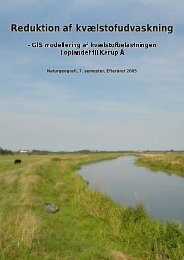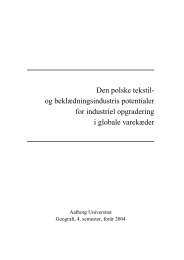Deglaciation dynamics following the Little Ice Age on Svalbard:
Deglaciation dynamics following the Little Ice Age on Svalbard:
Deglaciation dynamics following the Little Ice Age on Svalbard:
You also want an ePaper? Increase the reach of your titles
YUMPU automatically turns print PDFs into web optimized ePapers that Google loves.
Søren H. Rasmussen<br />
in streams towards <str<strong>on</strong>g>the</str<strong>on</strong>g> main channel in <str<strong>on</strong>g>the</str<strong>on</strong>g><br />
middle, and with <str<strong>on</strong>g>the</str<strong>on</strong>g> channel down of <str<strong>on</strong>g>the</str<strong>on</strong>g><br />
moraine.<br />
The area affected by channels and<br />
running water is smaller <strong>on</strong> Platåbreen than<br />
Larsbreen. On Larsbreen <str<strong>on</strong>g>the</str<strong>on</strong>g> slope gradient<br />
towards <str<strong>on</strong>g>the</str<strong>on</strong>g> main channel is larger;<br />
<str<strong>on</strong>g>the</str<strong>on</strong>g>refore a flow of debris will affect a<br />
bigger area. The middle part of Platåbreen’s<br />
fr<strong>on</strong>tal moraine is largely flat<br />
lying, meltwater from <str<strong>on</strong>g>the</str<strong>on</strong>g> glacier flow in<br />
<str<strong>on</strong>g>the</str<strong>on</strong>g> main channel and does not affect this<br />
area. The debris cover prevents <str<strong>on</strong>g>the</str<strong>on</strong>g> ice core<br />
from melting. The <strong>on</strong>ly water running in<br />
this area is yearly rain and meltwater from<br />
seas<strong>on</strong>al snow cover falling inside <str<strong>on</strong>g>the</str<strong>on</strong>g> area.<br />
Therefore <str<strong>on</strong>g>the</str<strong>on</strong>g>re is a small amount of water<br />
to transport sediments away from this area,<br />
compare to <str<strong>on</strong>g>the</str<strong>on</strong>g> main channels. On Larsbreen<br />
<str<strong>on</strong>g>the</str<strong>on</strong>g>re is <strong>on</strong>ly smaller local area <str<strong>on</strong>g>the</str<strong>on</strong>g>re<br />
<strong>on</strong>ly drain water falling inside <str<strong>on</strong>g>the</str<strong>on</strong>g> area and<br />
which does not has a meltwater channel<br />
near it.<br />
On Larsbreen most of <str<strong>on</strong>g>the</str<strong>on</strong>g> moraine is<br />
sloping, mainly toward <str<strong>on</strong>g>the</str<strong>on</strong>g> main channel in<br />
<str<strong>on</strong>g>the</str<strong>on</strong>g> middle. At Platåbreen <str<strong>on</strong>g>the</str<strong>on</strong>g> flat fr<strong>on</strong>tal<br />
moraine does not have a main slope toward<br />
any channel. Transport due to gravity is<br />
<str<strong>on</strong>g>the</str<strong>on</strong>g>refore smaller <strong>on</strong> Platåbreen than<br />
Larsbreen. Fur<str<strong>on</strong>g>the</str<strong>on</strong>g>r more <str<strong>on</strong>g>the</str<strong>on</strong>g> gravity forces<br />
are not in <str<strong>on</strong>g>the</str<strong>on</strong>g> same degree working<br />
toge<str<strong>on</strong>g>the</str<strong>on</strong>g>r <strong>on</strong> Platåbreen’s moraine as <strong>on</strong><br />
Larsbreen’s moraine.<br />
Preservati<strong>on</strong> potential<br />
The combinati<strong>on</strong> of cold climate and<br />
debris-cover is preventing <str<strong>on</strong>g>the</str<strong>on</strong>g> fr<strong>on</strong>tal<br />
glacier ice from melting. The glaciers has<br />
been retreating since <str<strong>on</strong>g>the</str<strong>on</strong>g> LIA, this means<br />
<str<strong>on</strong>g>the</str<strong>on</strong>g> melt rate is higher than <str<strong>on</strong>g>the</str<strong>on</strong>g> snow<br />
accumulati<strong>on</strong> rate. If <str<strong>on</strong>g>the</str<strong>on</strong>g> temperature<br />
c<strong>on</strong>tinuing to raise <str<strong>on</strong>g>the</str<strong>on</strong>g> melt rate will be<br />
larger and <str<strong>on</strong>g>the</str<strong>on</strong>g> warmer air temperature will<br />
affect ice deeper in <str<strong>on</strong>g>the</str<strong>on</strong>g> debris-cover. This<br />
process will c<strong>on</strong>tinuing until all ice is<br />
g<strong>on</strong>e.<br />
The melting process is slowing down <strong>on</strong><br />
Platå- and Larsbreen, because <str<strong>on</strong>g>the</str<strong>on</strong>g>y c<strong>on</strong>tain<br />
<str<strong>on</strong>g>Deglaciati<strong>on</strong></str<strong>on</strong>g> <str<strong>on</strong>g>dynamics</str<strong>on</strong>g> <str<strong>on</strong>g>following</str<strong>on</strong>g> <str<strong>on</strong>g>the</str<strong>on</strong>g> <str<strong>on</strong>g>Little</str<strong>on</strong>g> <str<strong>on</strong>g>Ice</str<strong>on</strong>g> <str<strong>on</strong>g>Age</str<strong>on</strong>g> <strong>on</strong> <strong>Svalbard</strong>:<br />
Implicati<strong>on</strong> of debris-covered glaciers dynamic and morphological setting<br />
Page 13 of 15<br />
large amount of debris. When <str<strong>on</strong>g>the</str<strong>on</strong>g> glacier<br />
melt it release debris, <str<strong>on</strong>g>the</str<strong>on</strong>g> debris cover<br />
getting thicker and <str<strong>on</strong>g>the</str<strong>on</strong>g>reby isolate more. In<br />
additi<strong>on</strong> <str<strong>on</strong>g>the</str<strong>on</strong>g> ice under <str<strong>on</strong>g>the</str<strong>on</strong>g> debris are active<br />
glacier ice, this means ice c<strong>on</strong>tinuing to<br />
flow towards <str<strong>on</strong>g>the</str<strong>on</strong>g> fr<strong>on</strong>t, and <str<strong>on</strong>g>the</str<strong>on</strong>g>refore more<br />
ice has to be melted. In this way <str<strong>on</strong>g>the</str<strong>on</strong>g> icecored<br />
moraine will last for l<strong>on</strong>ger than a<br />
dead-ice ice-cored moraine.<br />
By thinking <str<strong>on</strong>g>the</str<strong>on</strong>g> deglaciati<strong>on</strong> to <str<strong>on</strong>g>the</str<strong>on</strong>g> end<br />
and how <str<strong>on</strong>g>the</str<strong>on</strong>g> glaciofluvial process will<br />
affect <str<strong>on</strong>g>the</str<strong>on</strong>g> sediments under <str<strong>on</strong>g>the</str<strong>on</strong>g> deglaciati<strong>on</strong>,<br />
<str<strong>on</strong>g>the</str<strong>on</strong>g> preservati<strong>on</strong> potential for <str<strong>on</strong>g>the</str<strong>on</strong>g> moraine<br />
of <str<strong>on</strong>g>the</str<strong>on</strong>g> two glaciers can be estimated.<br />
At Larsbreen water running down <str<strong>on</strong>g>the</str<strong>on</strong>g><br />
sides of <str<strong>on</strong>g>the</str<strong>on</strong>g> valley and gravity because <str<strong>on</strong>g>the</str<strong>on</strong>g><br />
steep sides will work toge<str<strong>on</strong>g>the</str<strong>on</strong>g>r to transport<br />
sediments to valley floor, where <str<strong>on</strong>g>the</str<strong>on</strong>g>y will<br />
be reworked by a steam. The stream will<br />
transport <str<strong>on</strong>g>the</str<strong>on</strong>g> sediments out to <str<strong>on</strong>g>the</str<strong>on</strong>g> L<strong>on</strong>gyear<br />
River and with <str<strong>on</strong>g>the</str<strong>on</strong>g> river to <str<strong>on</strong>g>the</str<strong>on</strong>g> fjordsystem.<br />
Al<strong>on</strong>g <str<strong>on</strong>g>the</str<strong>on</strong>g> valley sides new rock-fall will<br />
be mixed with <str<strong>on</strong>g>the</str<strong>on</strong>g> previous moraine debris<br />
and with time <strong>on</strong>ly traces of rock-fall is<br />
left.<br />
At Platåbreen <str<strong>on</strong>g>the</str<strong>on</strong>g> main channels may<br />
c<strong>on</strong>tinuing to cut down into moraine and<br />
fur<str<strong>on</strong>g>the</str<strong>on</strong>g>r into <str<strong>on</strong>g>the</str<strong>on</strong>g> bedrock. In this way <str<strong>on</strong>g>the</str<strong>on</strong>g><br />
water c<strong>on</strong>tinue to prefer to flow al<strong>on</strong>g <str<strong>on</strong>g>the</str<strong>on</strong>g><br />
channel and maybe not shifting directi<strong>on</strong>.<br />
The flat fr<strong>on</strong>tal moraine may <str<strong>on</strong>g>the</str<strong>on</strong>g>refore not<br />
be affected by <str<strong>on</strong>g>the</str<strong>on</strong>g> runoff of water. In<br />
additi<strong>on</strong> <str<strong>on</strong>g>the</str<strong>on</strong>g> underlying surface is nearly<br />
flat, meaning that gravity transport has a<br />
low influence or a stabilizati<strong>on</strong> effect.<br />
These to factor toge<str<strong>on</strong>g>the</str<strong>on</strong>g>r means <str<strong>on</strong>g>the</str<strong>on</strong>g> debris<br />
from <str<strong>on</strong>g>the</str<strong>on</strong>g> flat fr<strong>on</strong>tal moraine has a high<br />
preservati<strong>on</strong> potential and may be found as<br />
thick debris-cover <strong>on</strong> <str<strong>on</strong>g>the</str<strong>on</strong>g> ground. The<br />
lateral moraines at Platåbreen may undergo<br />
<str<strong>on</strong>g>the</str<strong>on</strong>g> same processes as Larsbreen’s<br />
moraine.<br />
C<strong>on</strong>clusi<strong>on</strong><br />
Results of mapping <str<strong>on</strong>g>the</str<strong>on</strong>g> moraines at<br />
Larsbreen and Platåbreen have been<br />
presented and compared with o<str<strong>on</strong>g>the</str<strong>on</strong>g>r studies<br />
of <str<strong>on</strong>g>the</str<strong>on</strong>g>se glaciers and a model for a typical







